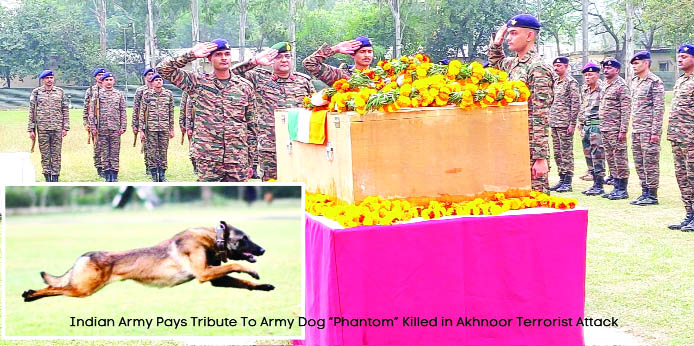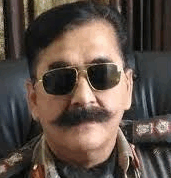Sniffing their way to heroism & immortality Army’s Dogs of war’

By Colonel Satish Singh Lalotra
‘What counts is not necessarily the size of the dog in the fight-it is the size of the fight in the dog.’-Dwight D. Eisenhower.
Of all the friends that this humanity has ever set its eyes upon, right from the days of a ‘hunter-gatherer’ nothing comes closer as ever to a dog which has redeemed himself in more ways than one in order to bag the moniker of being the ‘Oldest friend of man’.
Dogs have had a very checkered association with the man, often interchanging their roles from a messenger, scout, sentry, tracker, mercy dog to that of a hardened combat dog where ordinary soul would fear to tread.
The best part of these roles is that no amount of advancement of AI (Artificial intelligence), robotics, and even next level scientific innovations have been able to replace them till date.
Does it not sound the omniscient qualities of this unique animal which have been able to outpace, outperform, & finally outwit the tenets of modernity in all the spheres with aplomb?
What are those unique USPs that seem to be hardwired into the physicality of this animal which has been able to with stand the torrents of time and tide since millions of years and yet convince a modern world that it is not yet ready to discard this wonderful animal into the timelessness of human indifference?
That this animal still has a lot of fight left in himself needs no introduction to anybody by the way it keeps on churning stories upon stories of bravado even to this day unabated.
Of particular interest to a reader would be the latest exchange of the above mentioned qualities in the Indian army sniffer dog -‘Phantom’ who by his dogged determination, selflessness & single-mindedness left the best of combat soldiers in the just concluded CI/CT operation at Akhnoor ‘Jaw -dropped’.
With his heroics now splashed all over the national dailies and also among the army environment in the said operation that concluded on 28th October 2024 ‘Phantom’ has really immortalized the name bestowed upon him by his handlers by sacrificing his life in the line of the duty ; but not before saving scores of his fellow soldiers.
In the dense jungles of ‘Sunderbani’ sector of Akhnoor at a place called as ‘Asan’ the terrorists had targeted an army vehicle with automatics that prompted the troops to launch a large scale CASO (Cordon & search operation).
With the troops closing in on the trapped terrorists location, ‘Phantom’ – the sniffer cum assault dog who was leading the scout elements of this body of troops came under the terrorists arc of fire and was fatally injured as a consequence of the above.
Born on 25 May 2020 , ‘Phantom’ a ‘Belgian Malinois’ dog descended like thousands of his breed from the common type of herding dog as similar western European breeds such as the ‘Bouvier des Ardennes’, the Dutch shepherd and the German shepherd.
This particular breed was extensively used throughout the 19th century and also was the mainstay of Belgian police as well as their army during the First WW & 2 WW.
‘Phantom’ the hero of this CI/CT operation in the Sunderbani sector was an assault dog part of the K9 unit, a specialized unit of trained canines who take part in anti -terror and Counter-insurgency operations.
The male dog was issued from the RVC (Remount Veterinary corps) , Meerut and was posted on August 12, 2022 to the said unit.
Last year too, six year old army assault cum sniffer dog ‘Kent’ was killed while saving the life of a soldier during an encounter in J&K.
Kent had been part of nine ( 9) deadly operations before she was fatally shot dead by the fleeing terrorists in district Rajouri.
A female Labrador of 21st army dog unit had etched her place in the annals of Indian army CI-CT operations by her relentless pursuit of the terrorists in the UT of J&K, wherein ‘Operation Sujaligala’ leading the charge she managed to save the life of her handler.
Kent attacked the terrorist by moving ahead first in this particular operation at village ‘Narla’.
Carrying an army number 08B2, Golden coloured Kent was a special tracker dog which participated in her first operation on ‘Poonch-link up day’ on November 14 last year , followed by the induction in operation on December 30 th last year.
Kent took part further in search operations on January 27 th, September 11 and an investigation of theft on April 04th.
She took part in refresher courses and several training sessions to refine her skills too, as is the wont in the army to get its troops on top of the demanding situations that come in their way while performing their duties.
As part of the anti-terror operations in Jammu & Kashmir, a canine squad is inducted to carry out search operations.
Rather these canine squads are the typical ‘First responders’ to any evolving situation that warrants their express presence in shortest possible time.
The Indian army specially selects only those breeds of dogs that are a byword for their superlative intelligence, agility, and adaptability such as the ‘Great Swiss Mountain’, German shepherd, Belgian Malinois, Labrador retrievers, Cocker spaniels & Labrador to name a few.
These dogs undergo extensive training as also a comprehensive health examination to ensure they are both physically fit for service.
In the year 2017, the army also started inducting Indian breeds, specially ‘Mudhol Hound into the force.
The IA has a substantial amount of dog units that number more than 30 with each dog unit having about 24 dogs in a single unit.
As far as the training aspect of these special army dogs is concerned, it is rigorous and extensive.
As mentioned by me earlier too in this article, the training of these canines is the sole responsibility of the RVC & Center in Meerut, where a dog training school was established in 1960. These army dogs undergo training for at least 10 months.
During the training, a dog’s loyalty and combat skills are honed before they are inducted into the armed forces. Each dog is assigned to a handler who trains and guides them on a day to day basis.
However if handlers need change, the dogs require a 7 day period to get familiar with the new handler to efficiently obey his commands.
This single quality of an army dog to switch it’s both mental & physical conditioning as had been ingrained in him by his previous handler to a new found handler in a short span of 7 days is what endears him to the rigors of an army life that goes by the dictum of an ever changing scenario in a CI/CT operation.
Apart from refining skills to carrying out rescue and search operations, their intuitive abilities are also developed to assist soldiers in recovering explosives and detecting mines.
Handlers teach these dogs to control their bark in combat situations so as not to give the enemy away.
They are trained to respond to verbal and hand cues specific to the military. These dogs also undergo rigorous physical and tactical training so as to maintain stamina and strength and agility when called upon to do so in operations.
As part of the tactical training , these canines regularly undergo ‘Battle inoculation’ that familiarize them with the sights, sounds and smells of cordite, smoke, and human movements under stressful conditions.
They learn to remain calm under such demanding situations thus passing muster to be employed in real life challenges as obtained in the CI/CT environments of our country.
Further to sub-allot them for various tasks that are asked to be performed by them, these dogs are trained in specialized tasks like explosive detections, S&R missions (search & rescue), locating victims in rubble, tracking scents and basic medical aid.
Army dogs are deployed when they are at the age of 13 to 15 months and retire when they are 8 -10 years old.
The RVC & Center takes care of these dogs right from birth till the time they retire from their army duties.
After retirement, army dogs can also be adopted but with a caveat that has no parallel found anywhere in the world; a bond signed by the person adopting the dog , that he/she will take care of the dog.
Earlier army dogs were euthanized upon retirement or if they were unfit to carry out their duties.
There were primarily two reasons for this-the army considered adoption a security matter as these highly trained canines that were familiar with locations of the army bases could be wrongly used when fallen in wrong hands.
Secondly, animal welfare organizations would not be able to provide them with proper facilities.
However the practice changed after 2015, with the express intervention of the animal rights activist Maneka Gandhi, where now these dogs are now sent to work as a guard and some are sent to the rehab centers.
In the Indian context some of the army dogs who laid down their lives in the line of duty in the last few years are an impressive ‘Axel’ who on 22 July last year was fatally wounded while taking part in an operation in J&K, ‘Zoom’ again an army assault dog who went the same way as that of ‘Axel’ on 13th October 2022 taking in few gunshot wounds on his body but not before saving few precious lives of his fellow soldiers.
In the similar manner, ‘Mansi’ a 4 year old Labrador and a member of the army’s tracker dog unit was selected for a posthumous war honour after she and her handler both laid down their lives to prevent an infiltration bid by terrorists in north Kashmir.
Many of the readers may not be aware that when it comes to recognizing the valour of these unsung canines, the Indian army doesn’t leave any stone unturned to bestow upon them special awards for bravery like the COAS commendation card, VCOAS Commendation card and the army commander’s commendation card for their performance during various operations.
But then the icing on the cake for earth shattering job in assisting /capturing or killing world famous terrorists like Abu Bakar al-Baghdadi goes to the Belgian Malinois going by the name ‘Conan’ of US army.
Similarly ‘Diesel’ a bitch of the same pedigree was awarded the ‘PDSA Dickin medal’ after she was killed in the 2015 St Denis raid.
What better pedigree could a Belgian Malinois flaunt for himself than the fact ‘King Tut’ a dog of the above breed was the pet of late US President Herbert Hoover.
Indian army dogs belong to that genre of fighters who though 4 legged and seemingly docile by their demeanor transform into a fighting machine when called upon to by their handlers. They are not just loyal companions but vital assets to the nation’s security.
The vital gap that these dogs fill in where even a highly trained and motivated soldier may think twice before taking on a terrorist, is what makes them ‘jewel in the crown’ of CI/CT operations.
That ‘Phantom’ has lived up to his creed and breed of belonging to a Belgian Malinois at Sunderbani operation shouldn’t leave anybody to doubt that there are still certain facets of operations which best of tech gizmos fail to fill.
Ultimately quote-‘What counts is not necessarily the size of the dog in the fight, but the size of the fight in the dog’ unquote.
(The writer is a retired army officer)




